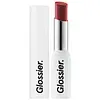What's inside
What's inside
 Key Ingredients
Key Ingredients

 Benefits
Benefits

 Concerns
Concerns

 Ingredients Side-by-side
Ingredients Side-by-side

Hydrogenated Polyisobutene
EmollientSynthetic Wax
AbrasiveCaprylic/Capric Triglyceride
MaskingSynthetic Fluorphlogopite
Vinyl Dimethicone/Methicone Silsesquioxane Crosspolymer
Bis-Diglyceryl Polyacyladipate-2
EmollientPolymethylsilsesquioxane
Kaolin
AbrasiveTridecyl Trimellitate
EmollientEuphorbia Cerifera Wax
Boron Nitride
AbsorbentIsododecane
EmollientSodium Hyaluronate
HumectantAgave Tequilana Leaf Extract
AstringentCarthamus Tinctorius Seed Oil
MaskingHelianthus Annuus Seed Wax
Skin ConditioningHelianthus Annuus Seed Oil
EmollientRicinus Communis Seed Oil
MaskingTocopheryl Acetate
AntioxidantTocopherol
AntioxidantDimethicone
EmollientDimethicone Crosspolymer-3
Skin ConditioningIsopropyl Titanium Triisostearate
EmollientDimethicone Crosspolymer
Emulsion StabilisingCaprylyl Glycol
EmollientIron Oxides
CI 15850
Cosmetic ColorantHydrogenated Polyisobutene, Synthetic Wax, Caprylic/Capric Triglyceride, Synthetic Fluorphlogopite, Vinyl Dimethicone/Methicone Silsesquioxane Crosspolymer, Bis-Diglyceryl Polyacyladipate-2, Polymethylsilsesquioxane, Kaolin, Tridecyl Trimellitate, Euphorbia Cerifera Wax, Boron Nitride, Isododecane, Sodium Hyaluronate, Agave Tequilana Leaf Extract, Carthamus Tinctorius Seed Oil, Helianthus Annuus Seed Wax, Helianthus Annuus Seed Oil, Ricinus Communis Seed Oil, Tocopheryl Acetate, Tocopherol, Dimethicone, Dimethicone Crosspolymer-3, Isopropyl Titanium Triisostearate, Dimethicone Crosspolymer, Caprylyl Glycol, Iron Oxides, CI 15850
Polybutene
Hydrogenated Polyisobutene
EmollientHydrogenated Polybutene
Prunus Armeniaca Kernel Oil
MaskingEthylene/Propylene/Styrene Copolymer
Octyldodecanol
EmollientSilica Dimethyl Silylate
EmollientRicinus Communis Seed Oil
MaskingPersea Gratissima Oil
Skin ConditioningRosa Canina Seed Oil
EmollientRubus Idaeus Seed Oil
EmollientOryza Sativa Bran Extract
Skin ConditioningHelianthus Annuus Extract
EmollientRosmarinus Officinalis Leaf Extract
AntimicrobialButylene/Ethylene/Styrene Copolymer
Aroma
Caprylyl Glycol
EmollientEthylhexylglycerin
Skin ConditioningTocopherol
AntioxidantPentaerythrityl Tetra-Di-T-Butyl Hydroxyhydrocinnamate
AntioxidantIron Oxides
CI 77742
Cosmetic ColorantCI 73360
Cosmetic ColorantCI 15850
Cosmetic ColorantCI 77891
Cosmetic ColorantPolybutene, Hydrogenated Polyisobutene, Hydrogenated Polybutene, Prunus Armeniaca Kernel Oil, Ethylene/Propylene/Styrene Copolymer, Octyldodecanol, Silica Dimethyl Silylate, Ricinus Communis Seed Oil, Persea Gratissima Oil, Rosa Canina Seed Oil, Rubus Idaeus Seed Oil, Oryza Sativa Bran Extract, Helianthus Annuus Extract, Rosmarinus Officinalis Leaf Extract, Butylene/Ethylene/Styrene Copolymer, Aroma, Caprylyl Glycol, Ethylhexylglycerin, Tocopherol, Pentaerythrityl Tetra-Di-T-Butyl Hydroxyhydrocinnamate, Iron Oxides, CI 77742, CI 73360, CI 15850, CI 77891
 Reviews
Reviews

Alternatives
Ingredients Explained
These ingredients are found in both products.
Ingredients higher up in an ingredient list are typically present in a larger amount.
Caprylyl Glycol is a humectant and emollient, meaning it attracts and preserves moisture.
It is a common ingredient in many products, especially those designed to hydrate skin. The primary benefits are retaining moisture, skin softening, and promoting a healthy skin barrier.
Though Caprylyl Glycol is an alcohol derived from fatty acids, it is not the kind that can dry out skin.
This ingredient is also used as a preservative to extend the life of products. It has slight antimicrobial properties.
Learn more about Caprylyl GlycolCi 15850 is the pigment color red. It is an azo dye and created synthetically.
Azo dyes need to be thoroughly purified before use. This allows them to be more stable and longer-lasting.
This ingredient is common in foundations, lipsticks, and blushes. This color is described as brown/orangey red.
It has many secondary names such as Red 6 and Red 7. According to a manufacturer, Red 6 usually contains aluminum.
Learn more about CI 15850Hydrogenated Polyisobutene is a synthetic polymer. Polymers are compounds with high molecular weight. Hydrogenated Polyisobutene is an emollient and texture enhancer.
In one study, Hydrogenated Polyisobutene showed better skin hydration levels than Caprylic/Capric Triglyceride. As an emollient, it helps keep your skin soft and hydrated by trapping moisture in.
Hydrogenated Polyisobutene is often used as a mineral oil replacement.
Learn more about Hydrogenated PolyisobuteneRicinus Communis Seed Oil is the INCI name for castor oil.
Castor Oil helps moisturize the skin. It is rich in a fatty acid called ricinoleic acid. This fatty acid helps prevent moisture loss on the skin. This helps keep your skin soft and hydrated. Ricinoleic acid also has anti-inflammatory and pain reducing properties.
Besides hydrating the skin, castor oil is also used to hydrate hair. By keeping the hair shaft moisturized, breakage is decreased. More studies are needed to show castor oil's effective on stimulating hair growth.
Castor oil is created by cold-pressing castor seeds and then purifying the oil with heat. It was used in Ancient Egypt as fuel in lamps and to help treat eye irritation.
The term 'fragrance' is not regulated in many countries. In many cases, it is up to the brand to define this term. For instance, many brands choose to label themselves as "fragrance-free" because they are not using synthetic fragrances. However, their products may still contain ingredients such as essential oils that are considered a fragrance.
Learn more about Ricinus Communis Seed OilTocopherol (also known as Vitamin E) is a common antioxidant used to help protect the skin from free-radicals and strengthen the skin barrier. It's also fat soluble - this means our skin is great at absorbing it.
Vitamin E also helps keep your natural skin lipids healthy. Your lipid skin barrier naturally consists of lipids, ceramides, and fatty acids. Vitamin E offers extra protection for your skin’s lipid barrier, keeping your skin healthy and nourished.
Another benefit is a bit of UV protection. Vitamin E helps reduce the damage caused by UVB rays. (It should not replace your sunscreen). Combining it with Vitamin C can decrease sunburned cells and hyperpigmentation after UV exposure.
You might have noticed Vitamin E + C often paired together. This is because it is great at stabilizing Vitamin C. Using the two together helps increase the effectiveness of both ingredients.
There are often claims that Vitamin E can reduce/prevent scarring, but these claims haven't been confirmed by scientific research.
Learn more about TocopherolThis ingredient is a combination of red, black, and yellow iron oxide pigments. This combination of colors is usually found in foundation, because it results in a "skin" color.